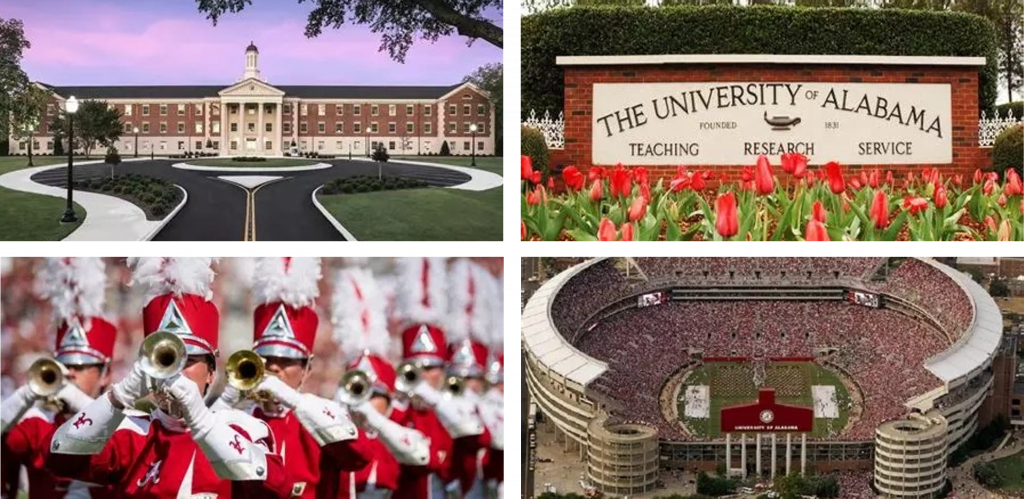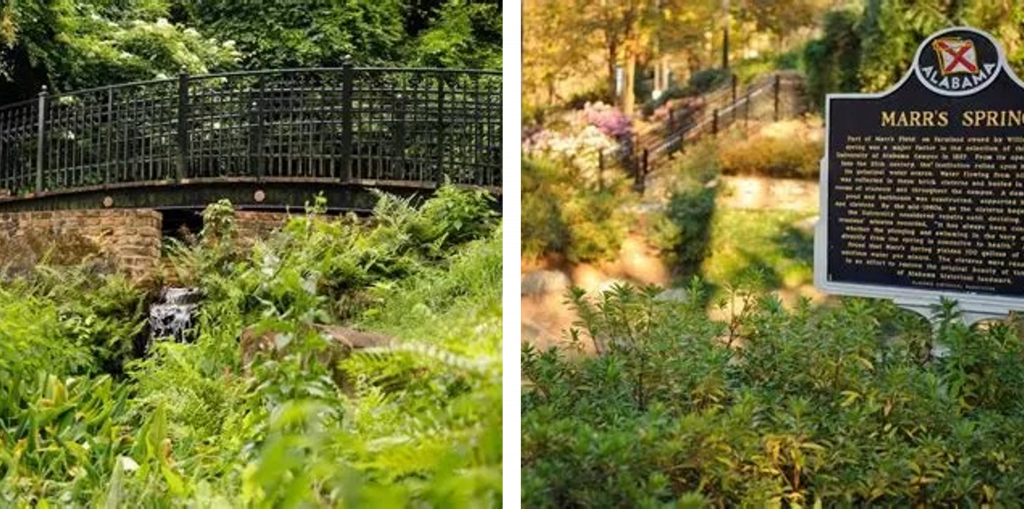
Roll Tide!
The University of Alabama
Location: Tuscaloosa, AL
Nickname: Crimson Tide
Type of School: Public Research University
Mascot: “Big Al” the elephant
Total student body: 40,846
University Established: 1820
Football Stadium: Saban Field at Bryant Denny Stadium
Capacity: 100,077
Team Colors: Crimson, Gray, and White

Alma Mater
Alabama, listen, Mother, To our vows of love,
To thyself and to each other, Faithful friends we’ll prove.
Faithful, loyal, firm and true,
Heart bound to heart will beat.
Year by year, the ages through Until in Heaven we meet.
College days are swiftly fleeting, Soon we’ll leave their halls
Ne’er to join another meeting ‘Neath their hallowed walls.
Faithful, loyal, firm and true Heart bound to heart will beat
Year by year, the ages through Until in Heaven we meet.
So, farewell, dear Alma Mater May thy name, we pray,
Be rev’renced ever, pure, and stainless As it is today.
Faithful, loyal, firm and true Heart bound to heart will beat
Year by year, the ages through Until in Heaven we meet.
Interesting Facts
Origin of "Crimson Tide"
By numerous accounts the nickname “Crimson Tide” was first seen in print in 1907 when reporter, Hugh Roberts from the Birmingham Age-Herald, described Alabama’s football game with the heavily favored Auburn Tigers. The weather was terrible, the ground was chewed up and turned into mud and muck. As the game went on, the orange Alabama clay and the iron-rich soil prevalent in the area started to show in the mud giving it a “red” color. This along with Alabama playing so hard, prompted Hugh Roberts to comment that the team played like a “crimson tide”. The name didn’t stick and become widely used, however, until Henry “Zip” Newman, the sports editor at the Birmingham News, began using it frequently to describe Alabama’s football team in 1919.
William Marr's Spring

When choosing land for the new University, the first trustees needed property with abundant sources of clear water. They purchased William Marr’s Spring, where chilly water flowed from hillside openings and could be collected in cisterns. After many years as the University’s water source, lounging spot and swimming hole, the spring and cistern system could not keep up with the University’s needs. Now the renovated and repaired spring is a campus landmark, still drawing students who want to enjoy its beauty and peace. The University of Alabama would not be located where it is today had it not been for the water flowing from Marr’s Spring.
Traditions
Ceremonial Mace
Few things represent UA more completely than the ceremonial mace, crafted from one of our oldest and most famous trees, the Gorgas Oak.
The Gorgas Oak, believed to be older than the University, was finally brought down by a windstorm in 1982. From its wood, Sebron E. Kelly, retired superintendent of building maintenance at UA, and other maintenance employees lathed part of the 52-inch pedestal and the entire head of the mace, which is set with four bronze castings.
The first bronze casting is the official seal of The University of Alabama; the second is Denny Chimes. The third casting is a triangle framing the lamp of knowledge with the words of the University’s mission: teaching, research and service. The fourth casting is Clark Hall, one of the oldest classroom buildings on campus and home of the College of Arts and Sciences.
Introduced at the May 1987 commencement ceremony, the ceremonial mace is always carried by the commencement marshal. Made from one of our trees, crafted by our employees, carried by our faculty and bearing the symbols of our history and identity, the mace is part of what makes every commencement ceremony unique for our graduates.

Trivia
- The first football game played at Bryant-Denny Stadium was against Mississippi State in 1929.
- UA’s Gorgas Library is named after Amelia Gayle Gorgas, the first female librarian in Alabama and the mother of William Crawford Gorgas, who helped eradicate yellow fever in the Panama Canal Zone.
- UA’s football team has won 18 national championships, more than any other team in the SEC.
- The university has a history of civil rights activism, including the desegregation of its campus in 1963.
- UA has a nationally-ranked nursing program that offers degrees at the undergraduate and graduate levels.
